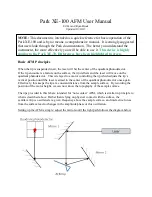
Manual for Primomic
microscopes
11.40.05
11.40.05/60
11.40.06
11.40.07
11.40.06/60
11.40.07/60
Construction of the
microscope:
Objectives:
All objectives are produced accor-
ding to DIN-standard. 40x and 100x
objectives have a spring mount to
avoid breakage of specimens and
objectives. The four-hole objective
revolver makes it easy to change
between the different objectives.
Some versions of the microscope
have a 60x objective instead of the
100x objectives. This 60x objective
also has a spring mount.
Focusing knobs and stage
stop adjustment:
The coaxial coarse and fine adjust-
ment knobs make it easy to attain a
sharp image. A vertical finger screw
is placed behind the mechanical
stage. When the lock nut is loose-
ned it is possible to turn the finger
screw, and thereby settle the upper
limit of the stage movement. This
protects the specimen from tou-
ching and/or damaging the objecti-
ves. The stage stop adjustment
(specimen protection) will also
make it easier to focus fast. The
microscope is delivered with a pre-
set stage stop adjustment and it
should therefore not be required to
make further adjustments.
Mechanical stage:
The specimen is placed on the
mechanical stage by pulling back
the movable handle of the speci-
men holder. Gently release the
handle and the specimen is placed
securely. The mechanical stage can
then be moved in the X and Y-axis
with the coaxial mounted knobs on
the vertical axle.
Condenser and iris diaphragm:
The condenser can be focused by
turning the condenser knob (left
side) up or down, until the best
image is obtained. The condenser
has a built-in iris diaphragm with a
little handle for adjustment. Closing
the iris diaphragm decreases the
light but increases the contrast and
depth of sharpness of the image.
Adjustment of the iris diaphragm
might be necessary when switching
between objectives.
Filters:
Filters of various colours can be
placed in the filter holder just bene-
ath the iris diaphragm. This can be
an advantage for example at grea-
ter magnifications where it will give
a more detailed image.
Bulb:
The bulb is placed in the lamp hou-
sing in the bottom of the main
microscope body. It is a 2-pin halo-
gen bulb 6 V / 20 Watt (Osram HLX
64250).
Fuse:
The fuse is mounted in the bottom
of the main microscope body. It can
be found under the plastic cover
labelled “FUSE”.
Connecting the microscope to
mains
The microscope is developed for
the use with 85-265 V / 50-60 Hz.
This is also apparent from the label
on the back of the microscope.
General use of the microscope:
- Put the microscope on a dry and
clean place.
- Place the optical head in the hole
at the top of the microscope
stand. Fasten it with the clamp
screw or the internal hexagon. In
the last case a hexagonal socket
wrench is enclosed.
- Put the mains cord in a socket
and turn on the microscope.
- Adjust the light intensity at mid
level with the brightness control
placed on the lover right side of
the microscope body. The inten-
sity of the light can be adjusted
to the desired level with this con-
trol slider.
- Place a specimen on the mecha-
nical stage.
- If the optical viewing head is
binocular it is necessary to adju-
st the eyepiece tubes to fit the
distance between the eyes. This
is done by pulling or pushing the
right and left black eyepiece
tubes. The adjustment is finis-
hed, when the image is comfor-
table and shows a completely
round image. Notice the number
on the graduated scale on the
Manual for Primomic microscopes
VE11400x
Item no. 114005/60 + 114006/60 + 114007/60
Rev. 16.01.2008
Gundlach A/S
Tel. +45 8694 1388
Silkeborgvej 765 · DK-8220 Brabrand
Fax +45 8694 2486
www.gundlach.eu

















